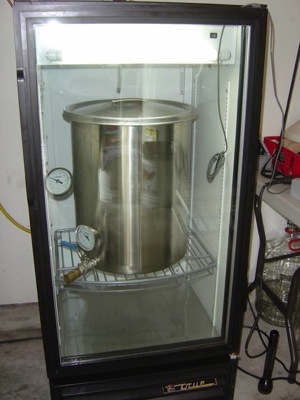Home of Brutus Ten!

It’s Ale about Brutus Ten!

Meet Brutus! Brutus "Ten" is an example of pure will power. This brewery was built from 2" X 2" Stainless steel square box tubing, all fabricated on our small apartment patio. This was quite an endeavor, and one I was not prepared to tackle. A new welding machine, many supplies and many, very many nights of hard work all paid off in the end. Here we have a great 11 gallon brewery, automated HLT and fully automatic RIMS. This system is controlled by two LOVE temp switches, each controlling a stainless ASCO valve plumbed into the gas system. This allows full automated control of the HLT and MT.
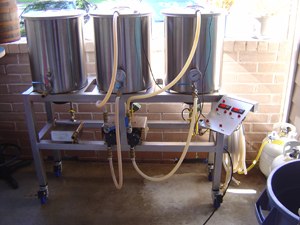

The control panel... Two LOVE temperature switches, main power switch, individual switches for each temp switch and their respective ASCO valves as well as switches for each March pump.
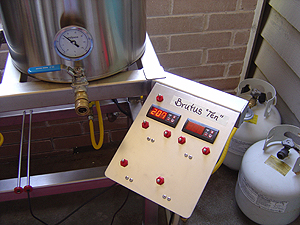

Notice the gas beam that is pressurized to about .4 psi. The welded tee fitting and all... The pilot branch is always pressurized at the 1/4 turn valve. The burner branch at the top of the tee is pressurized to the ASCO valve. When the LOVE switch opens the ASCO valve, gas flows to the burner that I have preset with its 1/4 turn valve. Of course with the pilot always lit, it fires up and only shuts off when the temp switch tells the ASCO valve to...
Have a homebrew and look at the pic...


Two march pumps with a decorative stainless steel shroud. Center, and mounted low keeps them right where the action is needed. I have always had great luck orienting the outlets in the up position. Fly sparging on this single tier requires two pumps to keep things flowing...
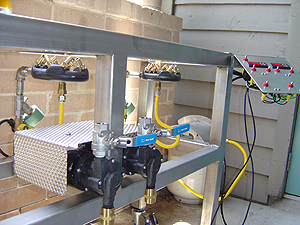

More of the burner details... I fire the pilots up at the start of brewday and adjust them to maintain a good flame.


Having two control systems now, one for the mash and one to maintain the HLT has made for some GREAT brewing!
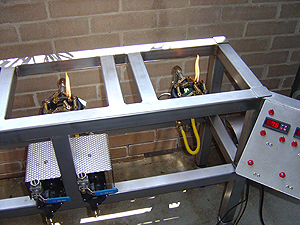

The full false bottom. I have tried just about everything in the mash tun. Bazookas, copper tubing... Several iterations of false bottoms. This has worked best. The mash clears very fast during recirculation, and I am getting great efficiencies pulling sugars from every part of the mash...
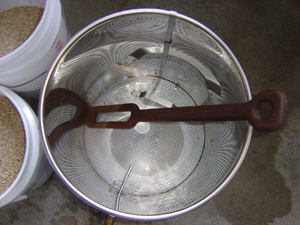

This system employs a direct-fire (very low heat RIMS) mash tun, slowly recirculating the mash from the bottom back to the top of the tun while the ASCO valve controls the amount of heat applied to the bottom of the tun...


Temp readings for the recirculating mash are taken at the outflow of the mash tun. This has proven to be the best method. The output is closest to the heat source. If the direct heat source is set at 150 degrees, the whole mash can never go over this temp. As the 150 degree recirculating wort is returned to the top of the mash, the mash as a whole will catch up to the output temperature. This is how I control the mash. It is very accurate.
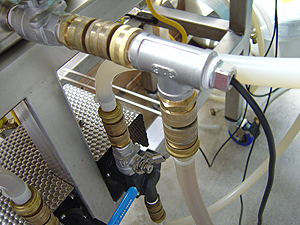

The HLT is set to recirculate to itself as well, recirculating the 170 degree sparge water back to itself using pump 2... I set the flow rates of each pot to match each other as best as I can.
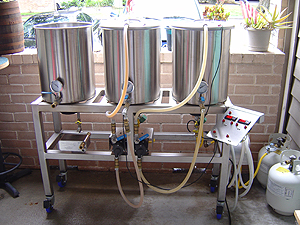

The sparge...
This is a BIG pain. All I have to do after getting the flow rates matched in the MT and the HLT is move the pot lid from the HLT to the MT, and the pot lid from the MT to the boil kettle... Hard work indeed.
Time for a homebrew!


Fly sparge whirlygig...
Since the beginning of my brewing days I have been a fly sparger at heart. I have moved back to the fly sparge method. In the Mash lid I have mounted a Williams Brewing fly sparger. This is one piece of pro stainless whirlygig! I have never been so pleased at my efficiency.
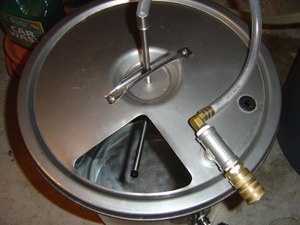

The tube in the return lid is simply a means to return the wort, the cooling water, the sparge water, whatever to it’s respective pot that I set it on. A 90 degree fitting attached to a curved piece of copper that when the lid is installed, the copper tube is actually touching the side of the pot on the inside. This can be used to return the hot wort from the mash to the kettle as I do during the sparge! (Hot side aerators I join you!!) or cooling, whirlpooling...
Whatever you can dream...
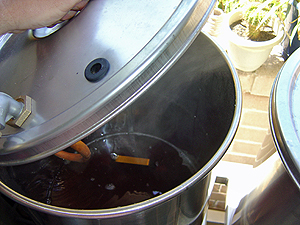

The mash tun is cleaned out and made ready for next weekend!
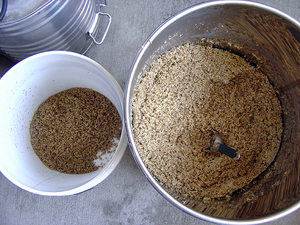

Boil kettle burner is lit... There is no need to automate this burner. As in any system, this phase should be left to instinct.
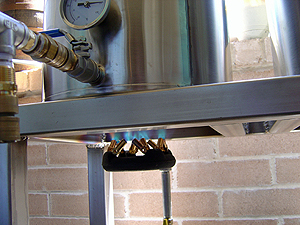

Coming to a boil...
This is where the low pressure burners kick in. The Sabco's we had (have) are also great, but for the patio, they were a bit much on the output. The low pressure regulator and burners here are perfect for 11 gallon batches. A little slower yes, but that is ok. I am also a firm believer in the 90 minute boil. Why boil for 60 when 90 is longer?
Get it?
HOMEBREW TIME!


The Therminator I use in an unusual manner, as I do everything else! I have the kettle flowing to the Therminator, then to the pump inlet, and back to the kettle through the pump outlet. I run it this way for the whole cooling cycle. It returns to the kettle. The wort is returned and sets up a great whirlpool as well... I just let it run like this man...
Freedom... I let it run...
Notice the frost on the cooling HLT tank at 35 degrees with 4ea 7lb bags of ice, and the kettle!
Das what I'm talkin bout...
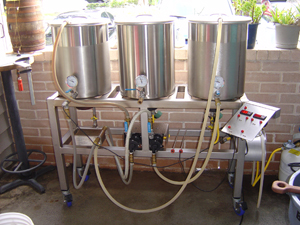

On the chilling side of the Therminator I first knock the heat out using a garden hose. This will bring the wort temp down to below 140 degrees in 3 minutes. This is my goal, to get below the DMS production threshold as fast as I can. Chilling is a real feat in Texas. Ground water is hot. To supplement chilling further, I switch the hoses to the HLT, where I pump freezing ice water through the Therminator. This will knock the whole batch down to 65 in under 20 minutes.
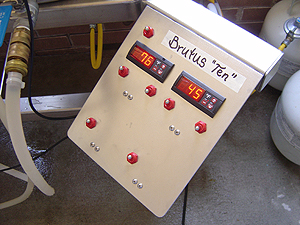

The HLT has now become a chill water tank. Using the second pump, I just pump the ice water through the Therminator (chilling side) and back to the top of the tank in the same manner as I am pumping the hot wort through the Therminator and back to the kettle. It is really a hands off system at this point. Both the cooling wort, and the chill water are recirculating within their pots, whirlpooling, lots of action, not dead spots. When done, I know that the whole batch is at 65, not just part of it...
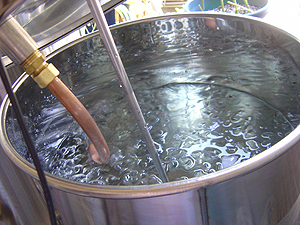

Bla Bla Bla!
